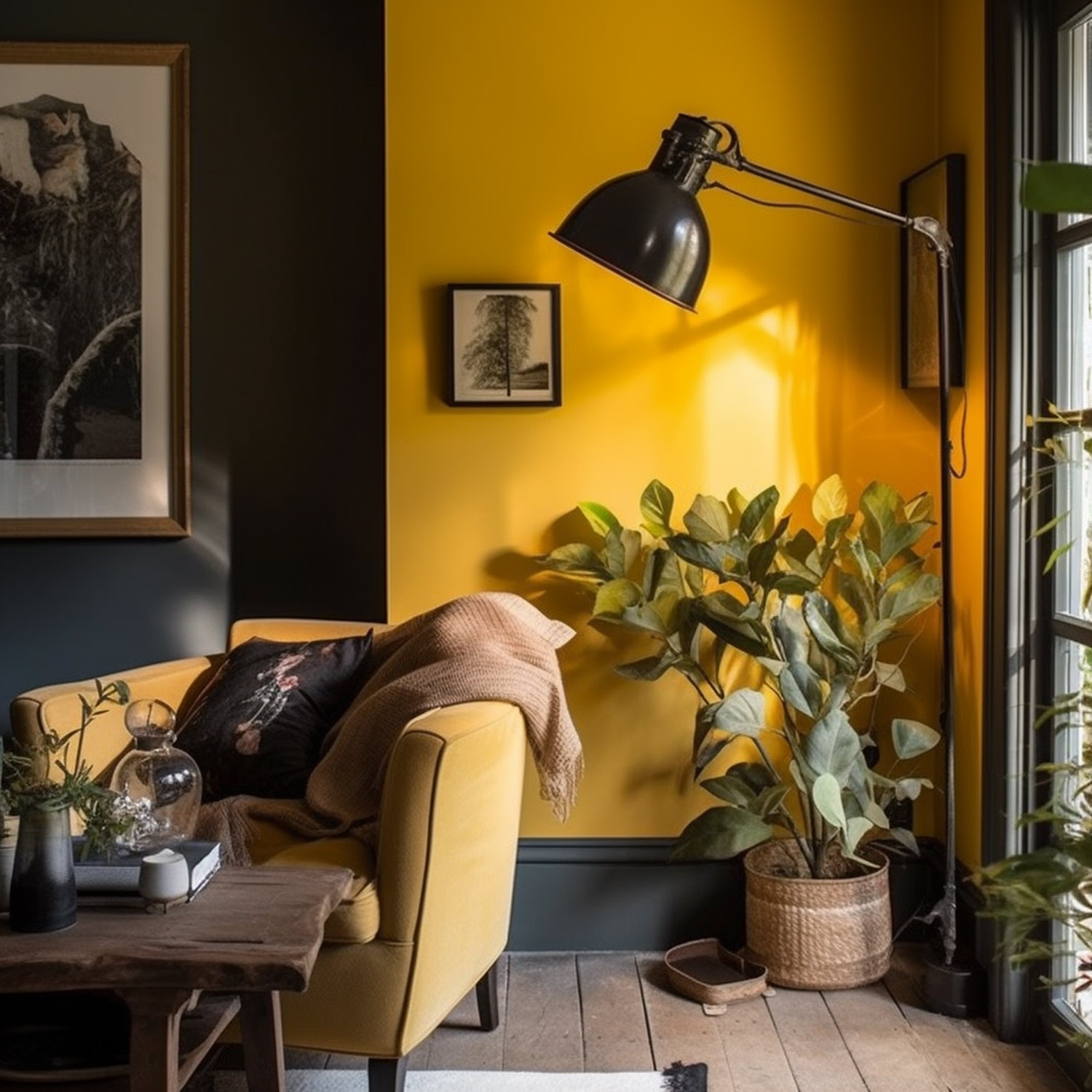Exploring the History, Trends, and Psychology of this Sun-kissed Hue
Yellow is a natural paint colour that has been associated with warmth, happiness, and vitality for centuries. As one of the most vibrant and versatile colours in the spectrum, it has held a significant place in the history of art, design, and architecture. This article will delve into the history of using yellow in home interiors, explore the various shades of light and dark yellows, discuss the psychology behind this colour, and provide some tips on how to incorporate yellow wall paints into your home.
The History of Yellow in Home Interiors
The use of yellow in interior design can be traced back to ancient civilisations. In Ancient Egypt, yellow was associated with the sun and used to represent life and energy. Romans used yellow pigments from natural sources to create frescoes in their homes, while the Chinese and Japanese cultures also embraced the use of yellow for its symbolism of power and prosperity.
During the Renaissance, yellow became a popular colour in European homes, thanks to advancements in paint technology and the accessibility of yellow pigments. The 18th and 19th centuries saw the rise of the colour in the Rococo and Victorian eras, where it was commonly used to signify opulence and wealth.
Why Use Yellow Wall Paints
Yellow wall paints can instantly brighten up any room and create a sense of warmth and cosiness. They can also help make a small room appear larger and more inviting.
Here are some reasons to consider using yellow wall paints in your home:
- Versatility: Yellow is a highly adaptable colour that can work well in various design styles, from traditional to modern.
- Mood enhancement: Yellow is known for its ability to boost mood and evoke feelings of happiness and optimism.
- Energy: Yellow is a stimulating colour that can invigorate a space and inspire creativity.
Light vs. Dark Yellows and Shades in Between
- Light Yellow: Soft and subtle, light yellows like buttercream, lemon sorbet, or pale daffodil can add warmth and brightness to a space without being too overpowering.
- Dark Yellow: Rich and intense, dark yellows like mustard, ochre, or saffron can make a bold statement and create a sense of depth in a room.
- Shades of Yellow: There are numerous shades of yellow to choose from, ranging from warm golden tones to cooler, green-tinted hues like chartreuse. Experimenting with different shades can help you find the perfect yellow to suit your home's style and personality.
Yellow Paint Trends
Yellow has made a strong comeback in recent years, with many designers and homeowners embracing its lively energy.
Some popular yellow paint trends include:
- Monochromatic Yellow: Using various shades of yellow within a single space creates a cohesive and harmonious look.
- Accent Walls: Painting a single wall in a bold yellow hue can add visual interest and help define a specific area in a room.
- Yellow and Neutrals: Pairing yellow with neutral colours like white, gray, or beige creates a balanced and calming atmosphere.
Read more: The Most Popular Interior Wall colours for Your Home
The Psychology of Yellow
Yellow is often associated with happiness, optimism, and mental stimulation. Studies have shown that exposure to yellow can improve mood, increase concentration, and even boost metabolism. However, it is essential to choose the right shade, as overly bright or intense yellows can cause agitation or anxiety in some individuals.
Pros and Cons of Using Yellow Wall Paints
Pros:
- Brightens and energises a space
- Creates a warm and inviting atmosphere
- Enhances mood and promotes happiness
- Versatile and adaptable to various design styles
Cons:
- Overuse of bright yellows can cause agitation or anxiety
- May show dirt or stains more easily than other colours
- Can be challenging to coordinate with certain colour schemes
Tips for Incorporating Yellow Wall Paints in Your Home
- Start Small: If you're unsure about using yellow, start with a small space like a bathroom, entryway, or accent wall to test the waters.
- Consider the Room's Function: Yellow works well in spaces where energy and activity are desired, such as kitchens, playrooms, and home offices.
- Balance with Neutrals: To avoid overwhelming a space, use neutral colours for furniture, flooring, and textiles to balance the yellow walls.
- Experiment with Shades: Don't be afraid to try different shades of yellow to find the one that works best with your home's lighting and overall style.
- Use Complementary colours: To create a cohesive colour scheme, pair yellow with complementary colours like blue, green, or purple.
Yellow wall paints can transform a room by adding warmth, energy, and a sense of happiness. Understanding the history and psychology behind this vibrant colour can help you make informed decisions about incorporating yellow into your home. By exploring different shades and trends, you can find the perfect yellow hue to create a welcoming and invigorating space that reflects your personal style.
Room by Room Guide: Incorporating Yellow Wall Paints into Your Home
Yellow is a versatile and vibrant colour that can add warmth, energy, and happiness to any space in your home. This room by room guide will help you understand how to use yellow wall paints effectively in different areas of your home, including kitchens, living rooms, bathrooms, hallways, and stairways.
Yellow paint for Kitchens
Yellow is an excellent choice for kitchens, as it evokes feelings of warmth, cheerfulness, and energy. Lighter shades like buttercream or lemon sorbet can create a bright and inviting atmosphere, while deeper hues like mustard or ochre can add depth and character to your kitchen. Pair yellow walls with white or wood cabinetry and neutral countertops to create a balanced and cohesive look. For a modern touch, consider incorporating stainless steel appliances and fixtures.
Yellow paint for Living Rooms
Using yellow in your living room can create a warm, welcoming, and uplifting space perfect for relaxation and socialising. Light yellows work well in traditional or transitional living rooms, while bold or dark yellows can add a contemporary flair. Complement yellow walls with neutral furniture, such as beige or gray sofas and chairs, and accent with pops of colour like blue or green through pillows, artwork, and area rugs. For added warmth, consider incorporating wood or natural elements like woven baskets and houseplants.
Yellow paint for Bathrooms
In bathrooms, yellow can bring a sense of brightness and cleanliness. Soft, light yellows like pale daffodil or honeydew can create a spa-like atmosphere, while bolder shades like sunflower or saffron can add a touch of drama. Pair yellow walls with white fixtures and tiles for a crisp and clean look, or opt for contrasting colours like navy blue or charcoal gray for a more striking effect. Be mindful of the bathroom's size, as overly bright or dark yellows may make small spaces feel cramped.
Yellow paint for Hallways and Stairways
Yellow can be an excellent choice for hallways and stairways, as it adds a sense of warmth and brightness to these transitional spaces. Light to medium shades of yellow work best in these areas, as they can make narrow spaces appear larger and more inviting. Complement yellow walls with white trim, neutral flooring, and strategically placed mirrors to enhance the sense of spaciousness. For added interest, consider creating a gallery wall with family photos or artwork in contrasting colours like black, blue, or green.
Yellow paint for Bedrooms
In bedrooms, yellow can promote feelings of relaxation and happiness. Opt for soft, muted shades like buttercream or pastel yellow to create a calming and restful atmosphere. Pair yellow walls with neutral bedding, curtains, and furniture, and accent with subtle pops of colour like lavender or soft blue. For a more dynamic look, consider using patterned wallpaper or textiles with yellow accents.
Yellow paint for Home Office
Using yellow in a home office can help stimulate creativity and improve concentration. Light to medium shades of yellow work well in these spaces, as they can create a sense of energy without being too overwhelming. Pair yellow walls with white or wood office furniture, and incorporate green plants for a touch of nature. For a more sophisticated look, consider using a darker shade of yellow like mustard or ochre and contrasting it with dark wood or black furniture.
Incorporating yellow wall paints into your home can transform each room by adding warmth, brightness, and a sense of happiness. By considering the function and style of each space, you can choose the perfect shade of yellow to create a welcoming and invigorating environment that reflects your personal style. Whether you opt for soft, subtle hues or bold, vibrant shades, yellow wall paints can breathe new life into your home.

Hi! I’m Chris, the founder of The Organic & Natural Paint Co, and I’m focused on the education and promotion of natural non toxic alternatives to chemical laden everyday products that we just take for granted. We have a choice, and I want to raise awareness of alternative products that don’t actually harm us!
This company is my way of pushing the awareness of better indoor air quality, something that I am personally passionate about due to my own children’s breathing medical conditions. I just couldn’t paint with big brand standard petrochemical paint any longer and wanted another solution.
Read more: About me
Twitter: NaturalPaintCo
Instagram: cleanairclubofficial


